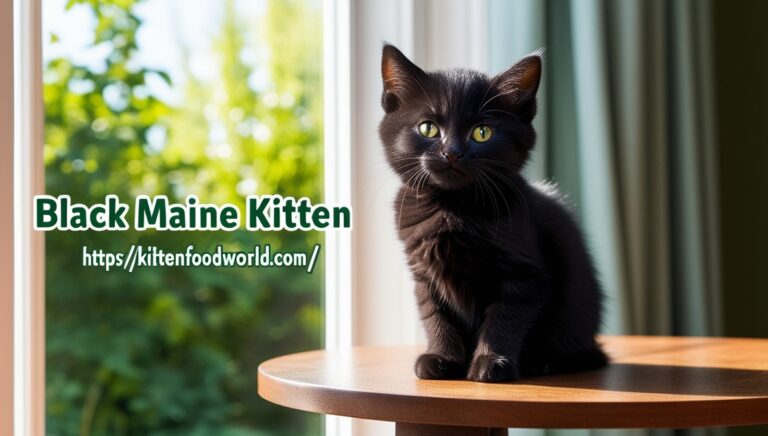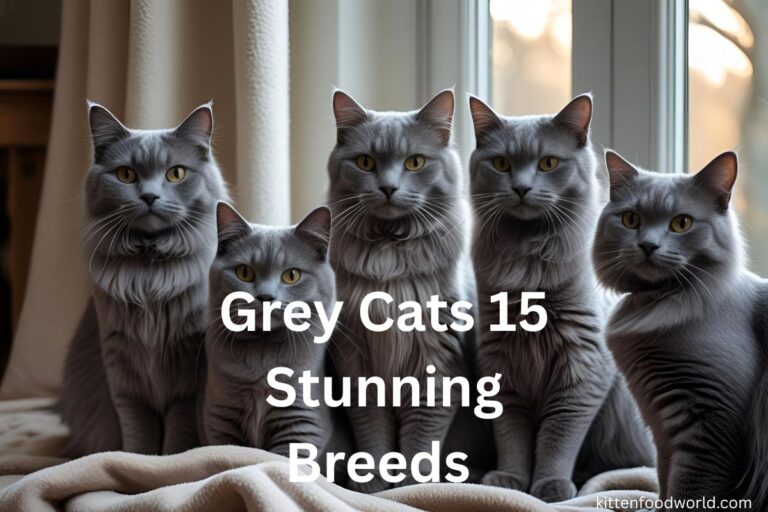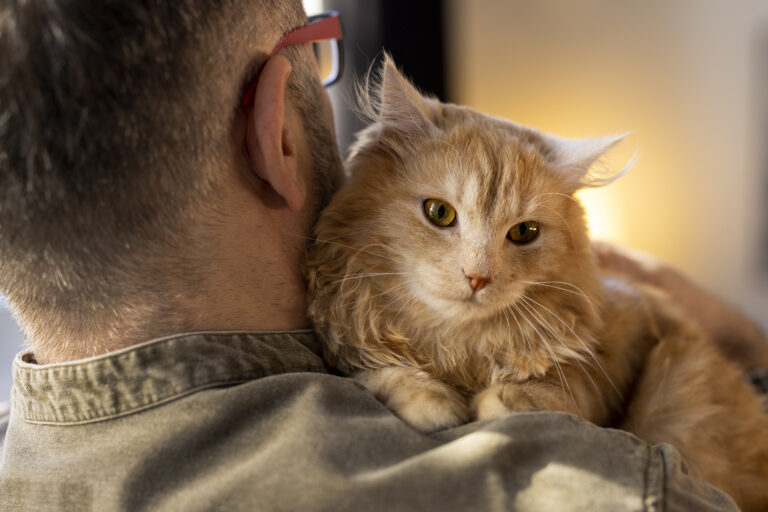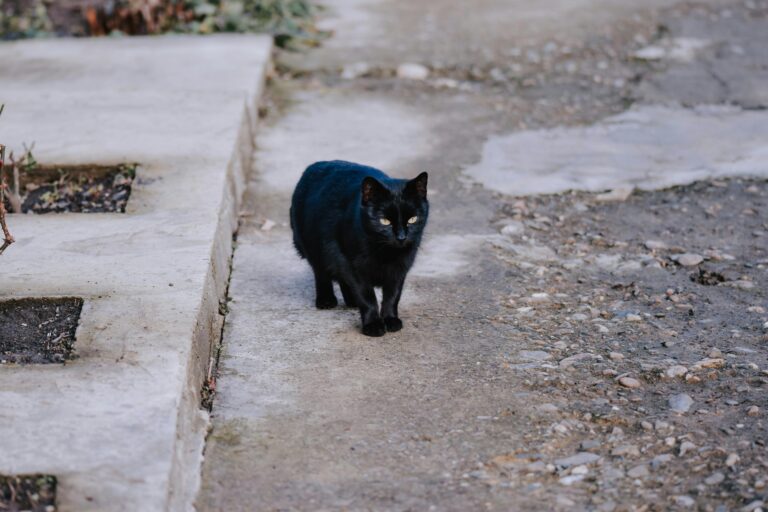Tuxedo Cat Personality, Traits & Care Tips Every Owner Should Know
Introduction
The tuxedo cat, known for its classy black-and-white coat, is often compared to a feline in formal wear. This sharp contrast of colors gives the tuxedo-cat a charming and distinguished appearance. With a smooth black coat accented by white on the chest, paws, and sometimes the face, these cats are impossible to miss.
Tuxedo-cats have become a favorite among pet lovers not just for their looks, but for their behavior. Known to be smart, affectionate, and at times mischievous, they bring energy and warmth to any household.
In this article, you’ll explore tuxedo-cat personality, learn how long tuxedo cats live, understand their grooming needs, and discover care tips that help them thrive.
Background Information
Despite their unique appearance, the tuxedo cat is not a specific breed. Instead, “tuxedo” refers to a bicolor coat pattern that appears in various cat breeds. This pattern consists of a black base coat with well-placed white patches that often resemble a suit or a “cat tuxedo.”
The tux cat can be found in breeds such as the American Shorthair, Maine Coon, British Shorthair, and Persian, among others. Because it is a pattern and not a pedigree, tuxedo-cats can vary in size, fur length, and physical features.
Stories and myths surround the tuxedo cat. In ancient Egypt, cats with black-and-white markings were believed to bring prosperity. Tuxedo-cats also appear in various cultures’ folk tales as clever and lucky creatures. Modern media continues this tradition, with famous tuxedo-cats gaining popularity in cartoons, movies, and viral pet videos.
Tuxedo cats make up a notable portion of bicolor cat populations. According to animal shelter data, bicolor cats, including the tuxedo type, are among the most commonly adopted due to their friendly nature and striking looks.

Personality Traits
Tuxedo cat personality is often described as outgoing and intelligent. Many owners report their cats being more vocal, interactive, and social than average. These cats tend to form close bonds with their humans and often follow them from room to room.
A tux cat may show playful behavior into adulthood, making them delightful companions. They enjoy puzzles, toys, and even learning simple tricks. This behavior might be influenced by the breed they belong to, but many tuxedo-cats share a sense of curiosity and alertness.
They’re not just energetic tuxedo-cats can be affectionate. They might curl up beside you on the couch, sleep at your feet, or greet you at the door. Their balance of independence and companionship makes them appealing to a wide range of pet owners.

Physical Characteristics
The classic tuxedo pattern features a solid black coat with white fur on the chest, belly, and paws — giving the look of a neatly dressed feline. Some tuxedo cats have white on their face, in patterns like a mask, a stripe down the nose, or a full white chin.
Eye color ranges from golden yellow to green. The contrast between their dark coat and bright eyes adds to their striking appearance. While the black and white look is standard, a grey tuxedo-cat offers a softer version of this pattern, often with a light gray coat instead of deep black.
Tuxedo cats may have a lean or muscular build depending on their breed. Long-haired and short-haired tuxedo-cats both exist, affecting how their coat appears and how much grooming is needed.

Health & Grooming
Since the tuxedo cat is not a specific breed, its health profile depends on its genetic background. However, regular wellness checks and vaccinations are essential. Some breeds with tuxedo patterns may be prone to dental issues, heart conditions, or kidney disease. Early detection and consistent veterinary care help manage these conditions.
For grooming, short-haired tuxedo-cats need minimal brushing — once or twice a week is usually enough. Long-haired tuxedo-cats, such as those with Persian or Maine Coon ancestry, may require brushing several times per week to prevent tangles and shedding.
Regular nail trimming, ear cleaning, and dental hygiene are also part of basic grooming. Creating a weekly routine keeps the cat comfortable and lowers the risk of issues.
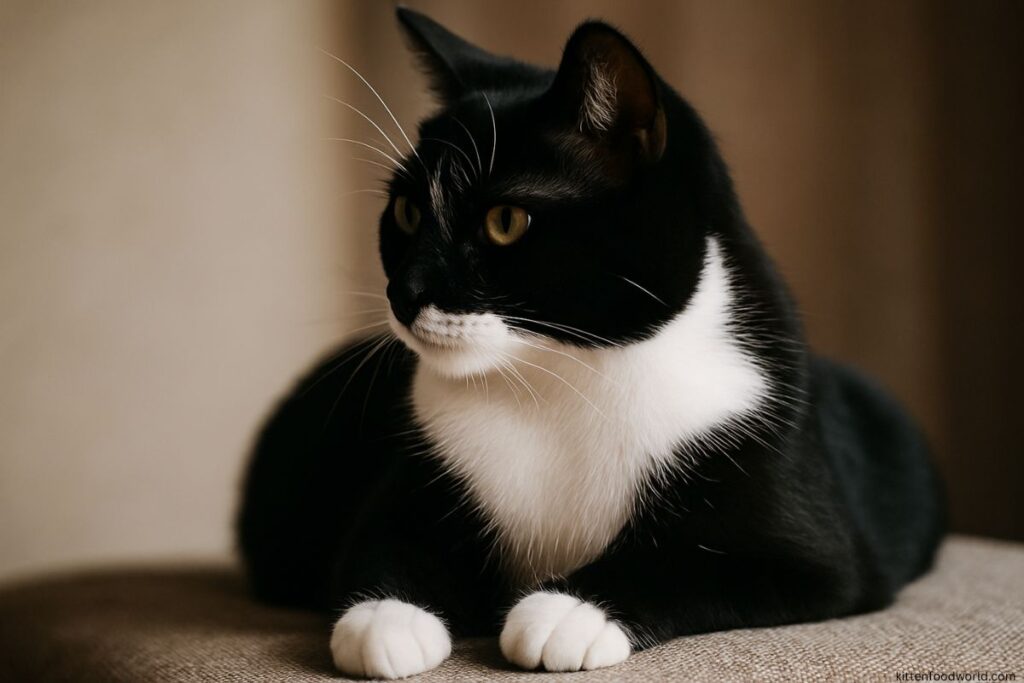
Feeding & Lifestyle Needs
Tuxedo cats need a balanced diet suited to their size, age, and activity level. High-protein cat food is ideal for active cats, while senior tuxedo-cats might need food designed for joint health and digestion.
Hydration is key, so providing clean water at all times is a must. Some cats prefer flowing water, so a pet fountain can be helpful.
Interactive toys, scratching posts, and climbing shelves contribute to the tuxedo-cat’s quality of life. Mental stimulation helps prevent boredom and reduces unwanted behavior. Creating a safe indoor space with occasional access to window views or secured outdoor areas can enrich their daily experience.
Exercise is just as important. Daily play sessions strengthen the bond between you and your tuxedo-cat while keeping them physically and mentally healthy.
Examples
Famous tuxedo cats include Sylvester, the clever cartoon cat from Looney Tunes, and Socks, the pet of former U.S. President Bill Clinton. These characters helped make tuxedo cats a symbol of intelligence and charm.
Many tuxedo-cat owners share stories of their pets displaying dog-like behavior — waiting at doors, playing fetch, or responding to their names. Some owners say their tuxedo-cat “talks” to them with different vocalizations or uses body language to communicate moods.
One cat owner described her grey tuxedo-cat as a “tiny guardian” that watches over her toddler during nap time. Another mentioned how her tux cat always wakes her up at exactly the same time every morning, as though it were part of its job.
Rescue shelters also report that tuxedo-cats adapt quickly and tend to get adopted faster than some other patterns. Their personalities and visual appeal make them memorable to potential adopters.
Conclusion
Tuxedo cats bring more than just good looks to the table. Their intelligence, energy, and affection make them stand out among bicolor cats. While every cat is unique, many tuxedo-cat owners report positive experiences with these playful and loving companions.
With proper care — from feeding and grooming to enrichment and health tuxedo-cats can live long, fulfilling lives. If you’ve ever wondered how long do tuxedo-cats live, the answer is often 12 to 20 years, similar to the bicolor cat lifespan. Their actual life expectancy depends on diet, healthcare, and lifestyle.
Whether you’re adopting a tux cat from a shelter or caring for one already in your home, these charming animals will likely bring humor, affection, and elegance into your life.
Have a tuxedo-cat story of your own? Share it in the comments below and let others know what makes your black-and-white companion special!
Frequently Asked Questions
What is so special about tuxedo cats?
Tuxedo-cats are known for their striking black-and-white coats, playful personalities, and strong bonds with humans. Many owners find them more intelligent and affectionate than other patterns.
What cat breed is a tuxedo?
Tuxedo-cats are not a specific breed. The tuxedo pattern can be found in breeds like American Shorthair, British Shorthair, Maine Coon, and Persian.
How much does a tuxedo-cat cost?
The price of a tuxedo-cat depends on its breed. Adoption fees range from $50 to $150, while pedigreed tuxedo-patterned cats may cost between $300 and $1,000.
How rare is the tuxedo-cat?
Tuxedo-cats are not rare. The black-and-white pattern is fairly common, especially among domestic short-haired cats.
Do tuxedo cats like to cuddle?
Yes, many tuxedo-cats enjoy cuddling and being close to their owners, though this can vary by individual and breed.
What is the lifespan of a tuxedo cat?
A tuxedo-cat’s lifespan typically ranges from 12 to 20 years, depending on health, care, and genetic factors.
What is the spiritual meaning of a tuxedo cat?
Some cultures associate tuxedo-cats with good luck, balance, or duality, symbolized by their contrasting coat.
Do tuxedo cats have health problems?
Tuxedo-cats can inherit health conditions based on their breed. Regular vet care helps prevent or manage issues.
Why do tuxedo-cats meow so much?
Tuxedo-cats are known to be expressive. Their vocal behavior often reflects their social nature and desire for attention.
What is the hardest cat to adopt out?
Older cats, black cats, and cats with health issues are generally harder to adopt than kittens or colorful breeds.
How do I know if I have a tuxedo-cat?
If your cat has a mostly black coat with white on the chest, paws, and possibly face, it’s likely a tuxedo-cat.
Which color cat is least adopted?
Black cats often face adoption challenges due to outdated myths or superstitions.
What is the 1 rarest cat?
The Ashera cat, a hybrid feline, is considered one of the rarest and most exotic cats.
What is the rarest cat color?
The albino cat, with no pigment at all, is one of the rarest color variations in felines.
What’s the most expensive cat?
The Savannah cat can cost up to $20,000, making it one of the most expensive cat breeds.
What cat likes to be held the most?
Ragdoll cats are known for their love of being held and their relaxed nature.
Why do tuxedo cats stick their tongue out?
Cats may stick their tongues out due to relaxation, dental issues, or as part of grooming behavior.
Why does my tuxedo-cat follow me everywhere?
Tuxedo-cats are social and often form strong bonds. Following you is their way of staying connected.
How much is tuxedo-cat worth?
While shelter adoption fees are usually affordable, purebred cats with tuxedo markings may be more costly.
What age do tuxedo-cats stop growing?
Most tuxedo-cats reach full size between 12 to 18 months, though larger breeds may grow up to 2 years.
Are tuxedo-cats usually talkative?
Yes, many tuxedo-cats are known for being vocal and engaging with their owners.
What to name a tuxedo-cat?
Popular names include Oreo, Felix, Socks, Domino, and Tux.
What is a gray tuxedo-cat called?
A gray tuxedo-cat has the same black-and-white pattern, but the black appears as gray. It’s still referred to as a tuxedo.
What gender are most tuxedo-cats?
Tuxedo-cats occur in both males and females at roughly equal rates.
At what age do cats misbehave the most?
Kittens between 6 months to 1 year may show more mischief as they become more active and curious.
What does it mean when a cat growls?
Growling can signal fear, discomfort, or territorial behavior. It’s a warning to back off.
How old is an 11 year old cat in human years?
An 11-year-old cat is roughly equivalent to 60 in human years.
What is the hardest color cat to adopt?
Black cats are typically the hardest to adopt, often overlooked due to superstitions.
What’s the least adopted cat?
Older, black, or special-needs cats are often adopted less frequently.
What is the rarest cat to own?
The Sokoke and Ashera are among the rarest cats in the world.
Do cats know their names?
Yes, cats can learn and recognize their names, especially with consistent use.
Do cats have a favorite person?
Many cats do show preference for one person, especially the one who feeds or plays with them most.
What does it mean when your cat licks you?
Licking can be a sign of affection, bonding, or sometimes grooming behavior.
Why are tuxedo-cats special?
Tuxedo-cats are loved for their smart personalities, social nature, and dashing appearance.
What is blepping?
Blepping is when a cat sticks out its tongue slightly and forgets to pull it back in.
Why do cats sleep with their head upside down?
This position usually indicates trust and comfort with their environment.
Why is my cat blooping?
Blooping — the sound of a belly flop or belly exposure — can mean relaxation or seeking attention.
What is carpet tongue?
It’s a playful term describing a cat’s rough tongue texture, similar to carpet.
What is a lock tongue?
This describes a cat’s tongue getting momentarily stuck outside the mouth after grooming.
Are tuxedo-cats snuggly?
Yes, many tuxedo cats enjoy snuggling and being close to their humans.
What is the rarest tuxedo-cat?
The rarest tuxedo-cats might be those with unusual coat placements or rare eye colors combined with the tuxedo pattern.
Why does my tuxedo cat meow so much?
Tuxedo-cats often enjoy communication. Frequent meowing can signal attention-seeking or a desire to interact.


